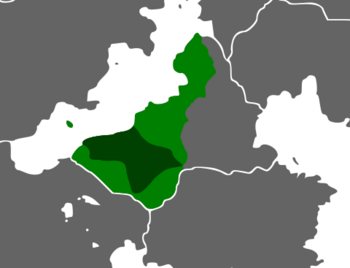Lushyodorstag
Kingdom of the Lushs Lushyodorstag | |||||||||
|---|---|---|---|---|---|---|---|---|---|
| 823 - 1913 | |||||||||
 Historical Lushyodor Kingdom in dark green, the Medenzag in green, and territorial expansions after the Ikonkivoyra in light green | |||||||||
| Religion | Docetic Christianism Emendatic Christianism | ||||||||
| Government | Monarchy | ||||||||
| Lushyodor Korran | |||||||||
• 820 - 840 | Garza III | ||||||||
• 1881–1913 (last) | Ansmar II | ||||||||
| History | |||||||||
• Baptism of Gerza III | 823 | ||||||||
| 1913 | |||||||||
| |||||||||
The Lushyodorstag or Kingdom of the Lushs was one of the two Finno-Ungaric languages Lush kingdoms that came from the partition of king Gerza I retinues. It was historically centered around the mountaineous region known as the Furodommark, even if with time it came to encompass all of modern southeastern Drevstran. While originally less wealthy than its eastern counterpart, and often considered to be a backwater, impoverished, region, The Lushyodorstag slowly emerged as one of the most important states in Eastern Belisaria following the Ikonkivoyra. It was notably one of the centers of the Eastern Renaissance (sometime nicknamed the "Alban Renaissance"), and one of the first state in the world to follow a policy of religious tolerance, with the first Edict of toleration published in 1259.
During the 13th and 14th centuries, the Lushyodorstag was known as the "Land of All the Heresies", being its in majority of Docetic confession, but also with important Emendatic and Orthodox Iconoclast communities. It was also considered to be a country of pirates and raiders, it's easily defensible borders, central position in Eastern Belisaria, poor natural ressources, and exclusion from both the Fabrian and Orthodox worlds that bordered it making it a privilegied origin for raiders, pirates, and mercenaries.
In 1690, Farza IV, king of the Lushyodors, inherited both the Principality of Yugstran and the Duchy of the Drev. But since these titles were part of [X] who refused to a see a foreign heretic in charge of these principalities, the Lushyodorstag began a long war to press their monarch's claim. Farza successfuly became the new Prince of Yugstran and Duke of the Drev after he defeated [X] armies in battle and converted to Orthodox Christianity, ending the war and uniting all three titles in a personal union known as the Triple Crown. The Lushyodorstag would continue as a constituent principality of what became known as Drevstran, until the beginning of the Drevstranese Civil War in 1913.
